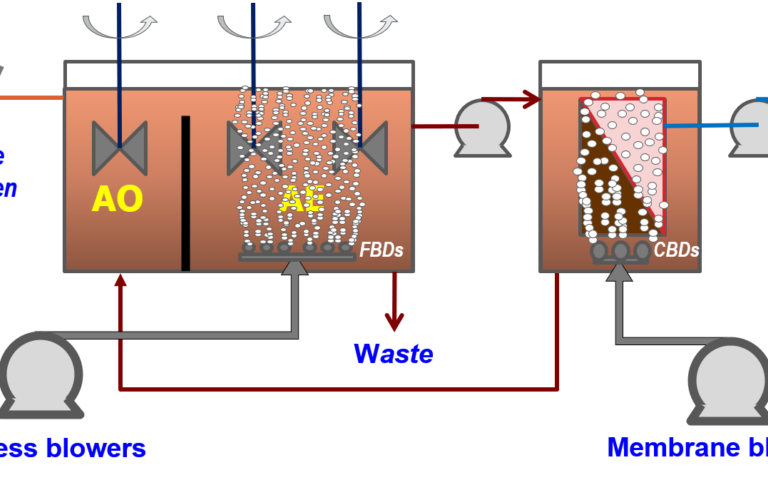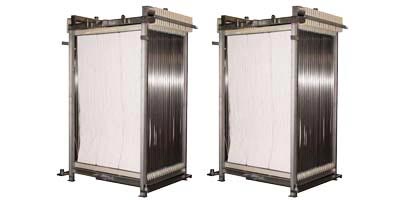Understanding the Basics of Membrane Bioreactor Systems for Wastewater Management
Wiki Article
The Advantages of Membrane Layer Bioreactors in Sustainable Wastewater Administration
Membrane layer bioreactors (MBRs) stand for a crucial advancement in sustainable wastewater management, efficiently merging biological treatment with advanced membrane filtering innovation. This combination not only improves effluent high quality by effectively removing contaminants but also opens avenues for water reuse in various applications, hence resolving the pressing need for source preservation. The compact layout of MBRs adds to considerable reductions in environmental influence and functional expenses. As the demand for lasting options increases, checking out the diverse benefits of MBRs might expose unexpected effects for the future of wastewater therapy systems.Summary of Membrane Bioreactors
Membrane layer bioreactors (MBRs) represent a substantial improvement in wastewater treatment innovation, integrating biological destruction with membrane purification to enhance the performance of the treatment procedure. This innovative system integrates the advantages of conventional turned on sludge processes with membrane modern technology, enabling boosted solid-liquid separation. MBRs use semi-permeable membrane layers to separate treated water from biomass, causing top quality effluent that can be recycled or securely discharged into the setting.The operational style of MBRs commonly involves a bioreactor where bacteria damage down raw material, complied with by a membrane layer device that filters the mixed liquor. This arrangement not just minimizes the footprint of the treatment center yet also enables for greater biomass focus and reduced hydraulic retention times. Additionally, MBRs can dealing with a bigger series of contaminants, including nutrients and microorganisms, making them ideal for numerous applications, from local wastewater therapy to commercial effluent handling.
The integration of MBRs into wastewater administration systems is a measure of an expanding fad in the direction of efficient and lasting techniques in ecological design. Their capability to generate high-quality effluent while reducing area needs placements MBR modern technology as a principal in modern-day wastewater therapy options.
Improved Effluent Quality

The membrane layer filtering process works as a physical obstacle, enabling the retention of microbes and particle matter, which adds to a clearer and cleaner effluent (Membrane Bioreactor). Furthermore, MBRs run at higher biomass focus than traditional activated sludge systems, advertising much more reliable biodegradation of contaminants. This brings about a decrease in biochemical oxygen need (BOD) and complete suspended solids (TSS) degrees in the final effluent
In addition, MBRs demonstrate superb performance in dealing with challenging wastewater structures, such as industrial effluents and wastewater with high nutrient tons. Because of this, the effluent created is often of better, enabling even more flexible disposal choices and lowered environmental influence. Ultimately, the improved effluent top quality achieved with MBR modern technology underscores its important role beforehand lasting wastewater monitoring practices.
Water Reuse Opportunities
The top notch effluent produced by membrane bioreactors (MBRs) opens substantial opportunities for water reuse in different applications. MBRs properly remove pollutants, consisting of virus, put on hold solids, and raw material, leading to cured water that fulfills or goes beyond governing standards for reuse. This quality permits the application of water recycling efforts throughout varied fields.One noticeable application remains in farming, where dealt with wastewater can be made use of for watering, advertising lasting farming techniques while preserving fresh water sources. In addition, Source MBR-treated effluent can be made use of for commercial procedures such as air conditioning, cleansing, and as a procedure water source, substantially lowering the need for company website safe and clean water in these procedures.
In metropolitan atmospheres, MBRs assist in making use of recovered water for landscape irrigation, toilet flushing, and other non-potable usages, adding to the general durability of water system systems. The assimilation of MBR modern technology in decentralized systems help in handling localized water needs, especially in water-scarce regions.
Reduced Ecological Effect
How can the fostering of membrane layer bioreactors (MBRs) contribute to a reduced ecological effect in wastewater management? MBRs dramatically improve the treatment performance of wastewater while lessening ecological disruptions. By integrating biological therapy processes with membrane layer filtering, MBRs effectively eliminate a wide variety of contaminants, including natural matter, nutrients, and microorganisms. This advanced filtration leads to higher-quality effluent, which is critical for securing aquatic environments and decreasing the worry on natural water bodies.Moreover, MBRs run at lower hydraulic retention times compared to standard systems, resulting in smaller treatment plant footprints. This small layout decreases land usage, therefore preserving all-natural environments and biodiversity. The procedure also produces much less sludge than typical methods, alleviating disposal obstacles and lowering greenhouse gas emissions connected with sludge administration.
In addition, MBRs facilitate the recovery of important resources, such as water and nutrients, adding to a round economic situation. By enabling water reuse for irrigation or industrial processes, MBRs help minimize freshwater shortage, hence advertising lasting water make use of techniques. Inevitably, the fostering of MBR technology stands for a significant stride in the direction of minimizing the environmental impact of wastewater management systems.
Economic Benefits of MBRs

In addition, MBRs assist in the manufacturing of premium effluent, which can be reused for different applications, such as agricultural irrigation and commercial procedures - Membrane Bioreactor. This reuse ability can considerably decrease water purchase prices, supplying a monetary incentive for markets dealing with stringent water regulations
The compact layout of MBR systems additionally leads to decreased land requirements, which is specifically useful in urban areas where realty is expensive. By reducing room, communities and markets can reduce land acquisition and upkeep costs.
Moreover, MBRs usually need less constant maintenance and have a longer life-span than standard systems, even more adding to cost financial savings. In summary, the financial advantages of MBRs-- varying from decreased functional expenses to land financial savings and effluent reuse-- make them a compelling selection for sustainable wastewater monitoring, providing both prompt and long-lasting economic benefits.
Final Thought
Membrane layer bioreactors stand for a transformative method to lasting wastewater monitoring, combining biological treatment with innovative membrane layer filtration for exceptional effluent top quality. Their ability for effective pollutant removal assists in water reuse, thereby conserving important freshwater sources. Furthermore, MBRs add to lowered environmental impacts with small styles and lower sludge generation. Economic advantages additionally improve their stability, making MBRs an encouraging solution for dealing with the difficulties of wastewater treatment and promoting sustainable resource management.
Membrane layer bioreactors (MBRs) stand for an essential advancement in lasting wastewater monitoring, successfully merging organic treatment with sophisticated membrane layer purification innovation.Membrane bioreactors (MBRs) stand for a considerable development in wastewater treatment modern technology, incorporating organic degradation with membrane filtration to enhance the performance of the therapy process.Achieving boosted effluent high quality is one of the most significant benefits of utilizing membrane bioreactors (MBRs) in wastewater therapy.Furthermore, MBRs show exceptional performance in dealing with difficult wastewater compositions, such as commercial effluents and wastewater with high nutrient tons.Incorporating membrane bioreactors (MBRs) right into wastewater administration not only lowers environmental influence however also offers significant financial advantages.
Report this wiki page